A good training plan is the first step toward a successful trek to Everest Base Camp. You all know that. But what do the pieces of EBC training include?
Everest Base Camp Trek training includes improving fitness levels by building lower and upper body strength, endurance, flexibility, longevity, cardiovascular conditioning, tolerance for thin air, and being comfortable walking at high altitudes with a backpack for a long time.
“Spectacular achievement is always preceded by unspectacular preparation.” Robert H. Schuller.
Today, we are here with a training plan for the EBC Trek to get your fitness in shape and also prepare you physically before embarking on this tough journey.
We will also list fitness tips and workouts necessary for a successful trip to Everest.
Table of Contents
- How do I train for the Everest Base Camp Trek?
- Physical Training Preparation for Everest Base Camp
- Hiking-Specific Training for Everest Base Camp
- Daily Workout Training Plan for the Everest Base Camp Trek
- Everest Base Camp Training Plan: Download the PDF
- Altitude training for Everest Base Camp when you start the tour
- How to Prepare Your Fitness for the Everest Base Camp Trek
- FAQs about Everest Base Camp Training
- In the end,
How do I train for the Everest Base Camp Trek?
EBC being the doorway to the highest mountain on the globe, there are difficulties presented by nature in terms of the climate, suffering, acclimatization, and rough walking paths.

Namche Bazaar, a Sherpa town where you spend your rest day.
You should be ready to suffer through them all and conquer the heights. Therefore, getting physically fit and strong is crucial.
With the right conditioning, nothing is impossible. The finest form of therapy to create a camp-specific mental environment is walking.
So, once you’ve decided, start hiking uphill for 3-5 hours at least twice a week. While you walk, carry a backpack that weighs 10–20 pounds. This will help you prepare to carry weight while walking.
Then, begin a training program in the gym or at home that helps you improve your strength and endurance. First, begin with a modest exercise regimen and build it up. In terms of weight-carrying capability, speed, and duration, one can progressively pump more.
It’s also advised to engage a local trainer to teach fitness classes. This individualized strategy will enable the trekker to receive tailored guidance on enhancements that fall under his or her scope as a trekker.
If you are at home and don’t have an instructor, then begin with a walk on the treadmill. You can slowly speed up. But focus on the duration. While trekking to Everest Base Camp, you can walk slowly for 5-7 hours but should cover long distances in a day.
The next thing you should do is take the staircase instead of the lifts. Doing so, your thigh muscles will tighten, and you can feel the strength in your legs.
Let’s dig more into how fit you should be for the EBC Trek and what training program you should follow to get in shape.
Everest Base Camp Trek’s training plan includes:
- Strength and Endurance Conditioning
- Flexibility fitness programs (Individual body part stretching, esp for hamstrings, glutes, hips, calves, lower back, and quadriceps)
- Climbing Conditioning (Harder workouts)
- Aerobic classes and cardiovascular conditioning (Examples: biking, rowing, and swimming)
- Hiking-specific training (walking uphill and downhill with a backpack of (10 to 15lbs)
Training Books to Consider
- The Outdoor Athlete by Doug and Courtenay Schurman
- Training for the New Alpinism: A Manual for the Climber as Athlete by Steve House and Scott Johnson
Physical Training Preparation for Everest Base Camp
Along with mental preparation for EBC Trek, one must start tracking their physical fitness levels because the mountains frequently deceive.
To condition the body, it is necessary to focus on the exercises that make calves, hips, quadriceps, and the lower back, among other body components, strong.
On top of all, building endurance is the cornerstone of the training plan for carrying the weighted backpack on the journey to the mountains.
For the best preparation, it is preferable to try the following methods of exercise:
Strength and Endurance Training to Prepare for the EBC Trek:
Don’t just go to the gym and do difficult exercises. Note that you need to be physically fit and strong enough to lug supplies throughout the entire route and not build your body to have the perfect shape.
Instead of using gym equipment that works for individual muscles, try doing exercises that involve entire body parts.
Some of the enjoyable exercises to try before the Everest Base Camp Trek are:
- Shoulder Presses
- Push-ups
- Lunges
- Side Lunges
- Sit-ups and toe-ups
- Squats
- Step aerobics
The above workouts improve your upper and lower body strength, which is crucial while you are on the route. Do these each day.
Every time you start strength-building workouts for a trek to Everest Base Camp, stretch your calves, lower back, hips, and quadriceps for about 5–10 minutes.
Then, when you start an exercise, do it 24 times. Rest for a while and continue again with the next exercise.
First, build a foundation for harder exercises and then shift to building strength. At least four to six weeks prior, start to focus on strength and increase the weight used as the days are nearer.
Flexibility Conditioning for EBC Hike:
With physical strength, flexibility is frequently disregarded. But you should incorporate it into your workout routine for the Everest Base Camp Trek.
Stretching, step-mill training, downhill walking, and running are some of the flexibility-testing exercises you shouldn’t miss.
Biking and swimming are additional sustained, moderate-intensity sports to incorporate into the training plan.
Aerobic Classes and Cardiovascular Conditioning:
To get ready for any treks in Nepal along high altitudes, aerobic workouts, and cardiovascular exercise are strongly advised. It’s important to do cardio training two to three times per week before your trek to EBC and aerobic exercises four to five times a week.
With this in mind, let’s first talk about aerobic classes.
When aerobic workouts are done right, they should get your heart rate up. This is excellent training that helps you sustain yourself in thin air. Some effective aerobic workouts include:
- Running along the stairs
- Box jumps
- Jumping jacks
- Burpees
- Jumping squats
- Zumba
- Spinning
- Running
- Cycling
You should get 4-6 aerobic sessions every week that last at least 45 to 60 minutes each. These training plans make you sweaty and out of breath, which is a similar situation you feel when trekking to EBC.
Now, let’s get into cardio training. It involves workouts that train the heart and lungs. Some cardiovascular training programs for Everest Base Camp include:
- Swimming, rowing, and biking
- At least 3-4 sessions of sustained activity lasting 30 minutes at a moderate intensity
- High-altitude fitness can be another good option to include in the training plan. Because of the technology used in the altitude gym, the reduced oxygen level mimics when there is significantly less oxygen.
Hiking-Specific Training for Everest Base Camp
When you choose EBC Trek, we assume you love hiking. So, the best way to train for the Everest Base Camp Trek is to go on long hikes.
Start early with slow-paced short hikes. When choosing to hike destinations, search for uphill and downhill routes with rough paths. You can increase the distance and weight you carry while hiking.
Remember to reflect on the challenges you face during the EBC Trek, i.e., rough terrain, carrying weight, walking for a long time, and dehydration.
Going on a hike regularly is the best way to test your fitness for the Everest Base Camp Trek.
Daily Workout Training Plan for the Everest Base Camp Trek
Before you set foot on the trail, make sure you have the right training plan for EBC and follow it accordingly. Below is another trekking plan. You can follow any of the schedules based on your fitness level.
MONDAY
|
TUESDAY:
|
WEDNESDAY
|
THURSDAY:
|
FRIDAY:
|
SATURDAY:
|
SUNDAY:
Note: This is a normal workout routine. You’re free to change the exercise pattern. This chart only serves as an outline to include every type of training making you fit for one of the most demanding treks: Everest Base Camp. |
Everest Base Camp Training Plan: Download the PDF
Altitude training for Everest Base Camp when you start the tour
There is a greater risk of acute mountain sickness (AMS) at higher altitudes. Acclimatization is therefore very necessary to become accustomed to the climate at an altitude of 5364 meters.
Anyone can experience altitude sickness at Everest Base Camp; it does not entirely depend on fitness level or age. For that, getting enough rest, climbing gradually, and drinking plenty of water may be your best options. Techniques for proper, deep breathing can be very beneficial.
Kathmandu itself is the first step towards acclimatizing. However, staying a few nights in Namche Bazaar (3,500 m/11,500 ft), helps one become accustomed to the local climate.
After the one-way Everest Base Camp Trek, a return by helicopter is the only option if there are safety concerns with the acute mountain sickness indications.
How to Prepare Your Fitness for the Everest Base Camp Trek
Here is some advice to help you get ready and stay fit for the amazing trek to Everest Base Camp.
Making Yourself Ready
Once you decide to land in Nepal, you’ve already won half the battle. First, choose a good time to visit EBC. Upon arriving in Kathmandu, you will become somewhat familiar with the topography of the mountainous country.
The different trekking terrains in Nepal range in difficulty from easy to challenging. Walk relatively easier routes and locations if you are new to trekking before moving on to EBC.
Plus, the best way to talk about safety and success would be to receive advice from an experienced EBC trekker.
Create a precise training schedule for Everest Base Camp.
Planning the workout design is crucial before tackling the hills and mountains. Gaining strength and conditioning will be simpler if your body is prepared to travel a long distance.
Before beginning, it’s crucial to have the right information at hand. Preparation should begin at least three to six months in advance. One can start getting expert counsel on exercise as soon as the plan is written.
Some of the important
- High-intensity interval training
- HIIT activities at home (burpees, kettlebell swings, sprints)
- Steady jogging
- Riding a bike
- Treadmill(45 minutes)
- Stair-stepping machine (10 minutes)
- Local hike in uneven terrain (5-6 hours, carrying some 25 lbs.)
- Rock Climbing
Before beginning the actual journey, acclimatization is crucial.
In the Namche Bazaar, you can take a brief step toward acclimatization. To ensure both success and safety, this is crucial. You are advised to maximize acclimatization days. Staying more nights in Namche is a comparatively safer choice.
Acclimatization days improve the body’s ability to produce more red blood cells, which training for Everest Base Camp may not.
This procedure will lessen the chance of experiencing high altitude sickness and make you physically fit to complete the trip.
Daily effort to break the old elevation record
Building a body that can endure gradual elevation gains is another excellent strategic training for the journey to Everest Base Camp. However, the strategy should match the distances being traveled.
Carrying the backpack while progressively increasing the weight can be incorporated into the workout. The experiment and the training will give participants the confidence to survive in environments with low oxygen levels, high atmospheric pressure, and physical exertion.
Also, having personal trainers with climbing experience can help develop positive points for long-term goals and training plans for the Everest Base Camp Trek.
To identify their training’s strengths and potential growth areas, one might choose between indoor and outdoor options.
Check your health status with a doctor
The severity can be reduced by being aware of high-altitude symptoms and how to prevent them. Even though a person’s blood pressure or hypertension may or may not affect their ability to hike, those with stage 2 hypertension are not strongly advised to go on an EBC climb.
According to studies, climbing heights raises blood pressure, so it is not safer.
If you have asthma, reaching EBC on foot is practically impossible. However, if you’re willing to give it a shot, bring everything you’ll need, such as steroids, antibiotics, or an inhaler.
A planned small-group trip to Everest Base Camp is also preferable. Typically, there are only 10 participants and 2–5 guides per session. Avoiding drinking alcohol and smoking and instead carrying preventative medications are some of the successful tips for the EBC Trek.
The best approach to assessing your current physical condition after a thorough examination is to see your doctor.
Take correct doses of vaccination
While trekking at high altitudes or throughout Nepal, vaccinations are not required. However, given that many viral infections have been wiped out in other nations, it may be something we at Heaven Himalaya propose.
See the Nepal Tourism Board and its mandated rules about vaccinations that overseas visitors should receive.
Improve Food and Water Intake Habits
Consuming the correct foods and staying hydrated is the holy grail for taking care of the body for the trek.
Being well-hydrated is something to keep in mind as you train for the Everest Base Camp hike. A body should be protected from sunburn and, if possible, exposed less to the sun.
Hydrating the body before a hike will increase the body’s ability to endure high-altitude, low-oxygen conditions. Keep yourself hydrated at all times. It’s crucial to consume 4–5 liters of liquid before the journey.
Plus, an important ritual for the walk is to ensure that the body receives the proper number of calories and nutritional necessities. Along the trip, finding better lodges can provide the body with essentials to help it avoid food-related health issues.
FAQs about Everest Base Camp Training
What are the important gears to be familiar with while training for the Everest Base Camp hike?
Having enough clothing is just as important as preparing the body for physical endurance. It’s important to wear comfortable clothing and Merino wool layers. An unavoidable tool to combat the extreme weather can be rest and sleep that can adapt to zero to minus 30 degrees centigrade.
You will be wearing gloves, a down jacket, hiking boots, trekking pants, and other necessary clothing for trekking to Everest Base Camp. So, you should be comfortable wearing these while you start your training plan.
The most necessary thing is hiking boots. So, never forget to give your hiking boots a break, either to prevent blisters or soreness.
The best boots for trekking are those of the highest caliber, offering excellent ankle support, breathability, waterproofing, an elastic-free sole, low weight, and warmth. However, invest in a pair of cozy boots that provide cozy ankle support.
What can we expect on the Everest Base Camp Trek?
Every good thing is wild and unbound. A little sliver of heaven in the Himalayan wilderness is Everest Base Camp.
While many people have expressed fear at the thought of being at that height, in that climate, and at that distance, it is unquestionably a 10- to 12-day climb up to a height of 5,000 meters.
Nobody needs to be an experienced hiker to experience being at Everest Base Camp, as it is a well-developed trekking route. However, gathering knowledge is essential if you want to enjoy the experience and make it safer. Beginners to EBC should hike with great caution.
For the trek to Everest Base Camp, two months of training or preparation are necessary.
Should I train with my backpack on, or is there a porter available on the trek?
While training, pack a light backpack and walk along the path that is very uneven and uphill.
During the trip, local sherpas who are engaged as porters can help carry some weight (not over 25 kg), but you should at least carry your small backpack with important items.
In the end,
The life-changing experience of trekking at the foot of the massive Everest peak is a dream of many. Only a few of them attempt to do it because the trek is daring and requires extremely strict preparation. But, if you follow our training plan, then there’s no way you cannot complete the most popular trip.
Before the last weeks of the trek start date, reduce the amount of exercise. Make sure you are physically and mentally prepared. Give your body some time to rest and prepare itself. Don’t try new foods or drinks in EBC that might disturb your metabolism.
See what the past trekker has to say about the EBC Trek preparation.
The difficulty level of this trek is moderate. So it’s not a big deal to complete the trek if you’re fit. However, you need to follow a few things that’ll make the EBC trek easier.
- Quit drinking and smoking at least 1–2 months before the trek. Drinking causes dehydration and so do high altitudes. Keeping yourself hydrated during the trek is extremely important or there’s a high chance you may become a victim of severe altitude sickness. And when it comes to smoking, it reduces your lung capacity and you start getting tired easily. Trust me, you don’t want to be catching your breath every 5 mins reducing your speed as well as the speed of your team.
- If you’re going to carry all of your luggage on your back, without hiring a porter, get used to carrying weight on your shoulders. Once your body starts getting exhausted, you feel that your rucksack is your biggest enemy. I’m not saying that you should carry your sack anywhere and everywhere you go, just start with some push-ups and pull-ups that’ll increase your shoulder strength. Trust me, it helps!
- If you have to buy new trekking shoes for yourself, buy them at least 2–3 weeks before the trek and use them as much as possible. Getting comfortable in the shoes is extremely important and you’re able to walk easily without a lot of problems. This will also reduce the chance of a shoe bite. When in the mountains, illness and injuries are forms of Satan who come to meet you!
- Keep around 15 inner garments, 4–5 t-shirts, and 3–4 pairs of pants. Change your garments every day before your trek. You don’t get a chance to wash them and even if you do, drying them is impossible.
- Keep lots of chocolates with you. As the altitude increases, almost everything tastes the same. Not because the food is bad, but just because you lose your sense of taste. I remember, at one point the only two tastes I used to sense were sweet and “others”.
- Make sure you strengthen your legs. This is one of the most important points that I believe will help you. If your lower body is weak, the entire trek becomes miserable and you lose all the fun elements of the trek just because you’re so busy resting. I don’t think I need to elaborate much on this point for obvious reasons.
- The most important point of the entire trek is to keep a positive attitude. If you start thinking of giving up, your body naturally starts to show signs of exhaustion and you feel weak. Trust me, it’s just a phase. You’re not tired and you have much more potential to continue the trek and enjoy the scenery. If you feel that you’re too tired, just distract yourself by looking at the mountains or talking to people. These two things give you a lot of energy and positivity. Never say that you feel weak or you want to give up! It makes you miserable and demotivates the others to continue!
The trek is super fun and super amazing! I hope you have a great time! – Aniruddha Awalgoankar
The above Everest Base Camp training can be customized according to your fitness level and strength.
Have a question about how to build a training plan for Everest Base Camp?
Heaven Himalaya is always available to guide you all the way.

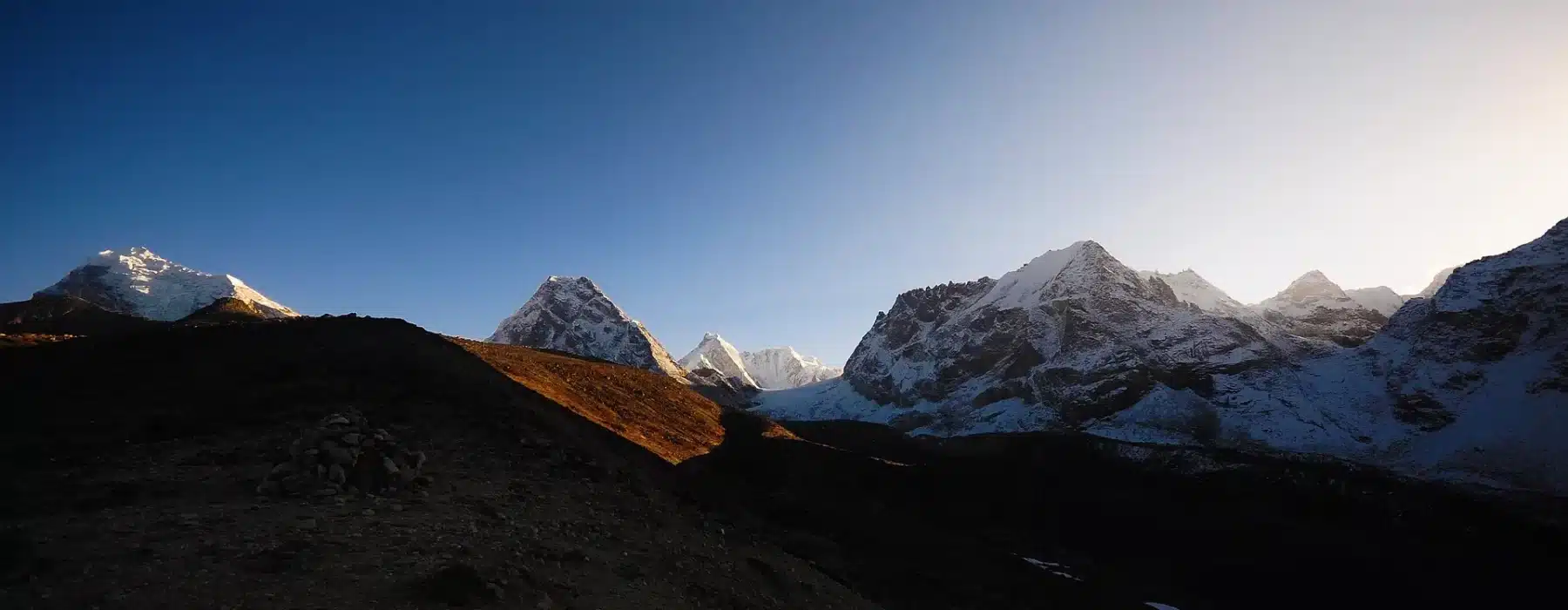

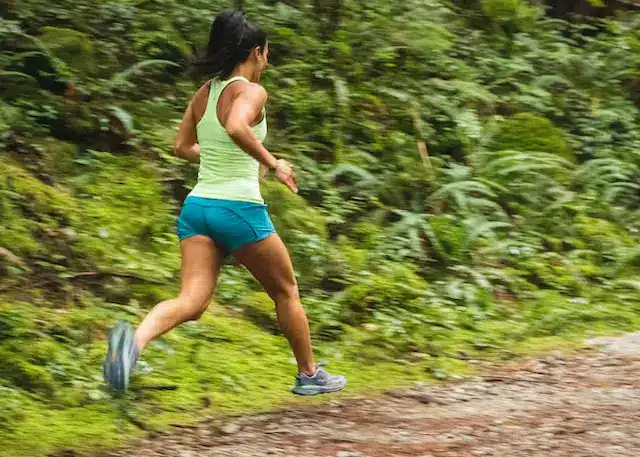

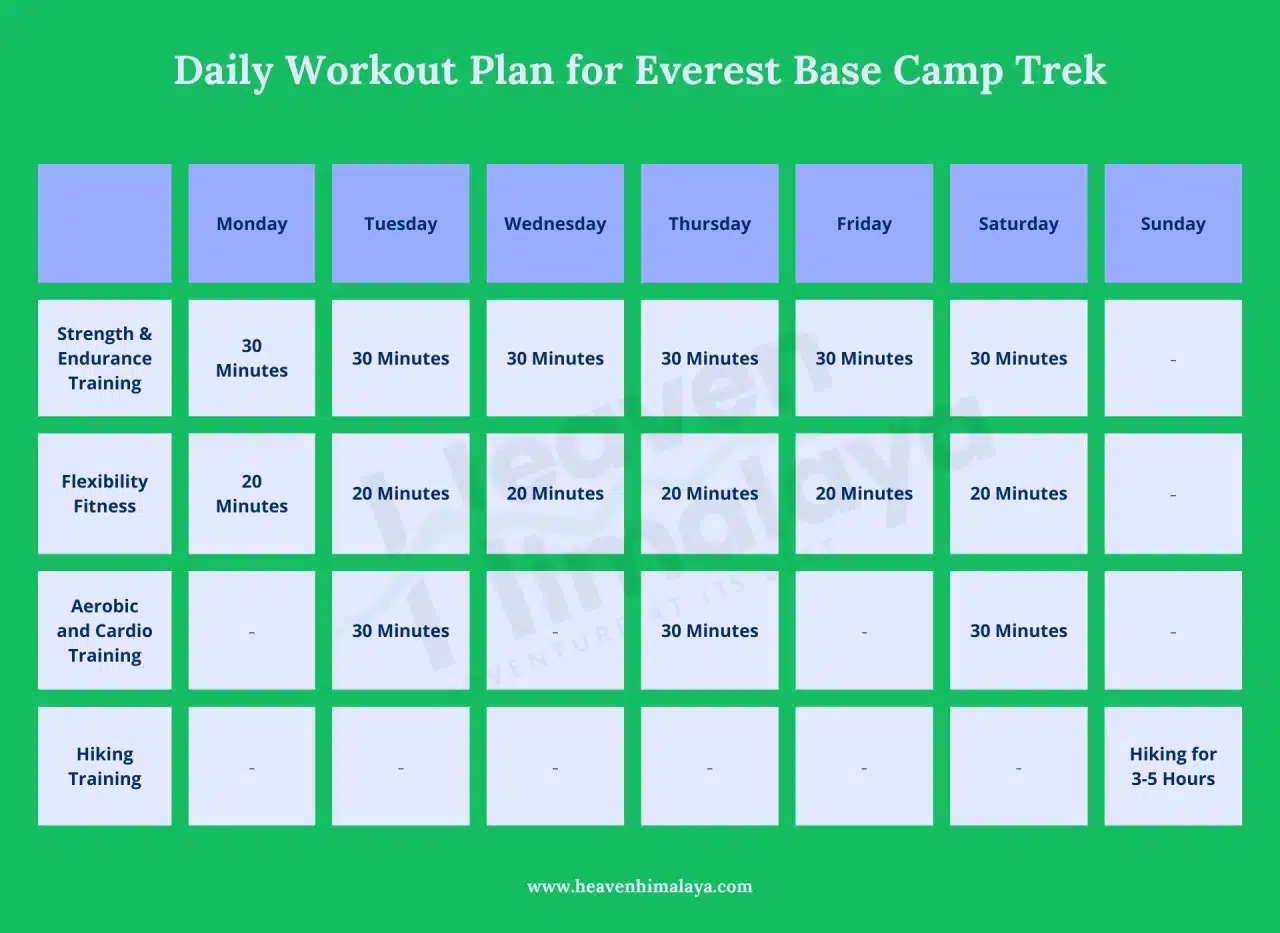

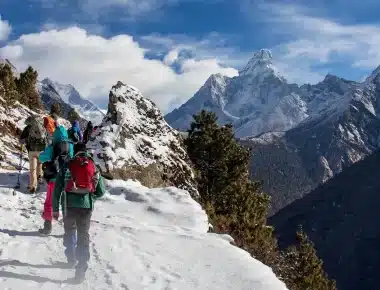
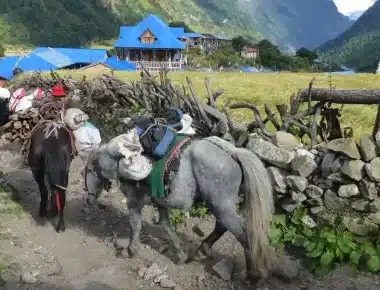
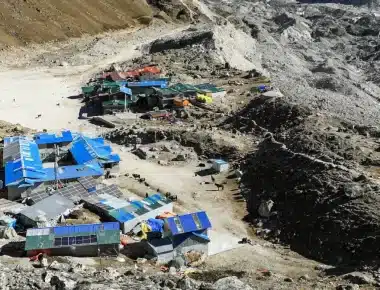
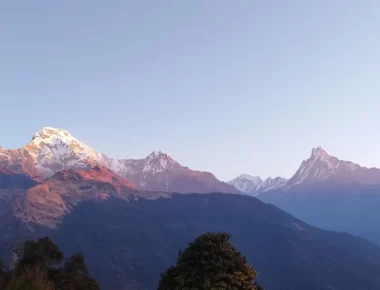

Thank you so much for such a lovely article with informative content. Hope to see more of a similar article.